Technical Data Linear actuator Zip Chain Actuator Selection
Selection Chart
The chart to the right presents the relationship between stroke and basic capacity.
Select a suitable model by confirming the required thrust per ZCA and stroke in the chart.
If more detailed examination is necessary, check if the selection suits the application using the calculations shown below.
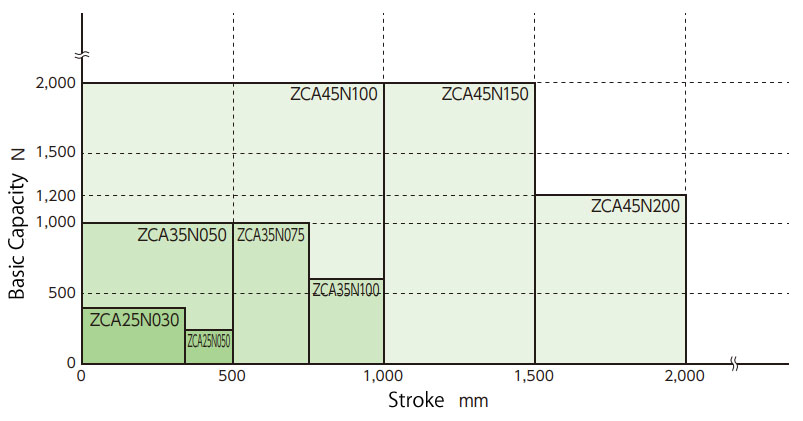
Selection Method
Machine to be used ..... Machine structure, number of ZCAs to be used, operating environment, etc.
Load ..... Load characteristics, load/workpiece mass, drive source, drive system, etc.
Mounting style ..... Mounting direction (lifting, horizontal, suspending), linear guide system
Operating speed ..... Speed required for ZCA operation
Stroke ..... Actual stroke used
1. Calculate the adjusted load Fs
Consider the characteristics of the load, refer to the service factor (Table 1), and then calculate the adjusted load (Fs).
Adjusted Load Fs N{kgf} = Required thrust P N{kgf}×Service factor Sf
Table 1 Service factor
| Load characteristics | Usage examples | Service factor Sf |
|---|---|---|
| Smooth operation without impact Small load inertia |
Switching a conveyor direction | 1.0 to 1.3 |
| Operation with light impact Medium load inertia |
Transfer equipment Raising and lowering lifters |
1.3 to 1.5 |
2. Calculate the thrust required per unit Fs1
Obtain the thrust required per unit (Fs1) from the adjusted load (Fs).
If multiple units are operated simultaneously, calculate Fs1 by referring to the multiple factor (Table 2).
Thrust per ZCA Fs1 N{kgf} = Adjusted Load Fs N{kgf} ÷(Number of multiple units ×Multiple factor Fg)
Table 2 Multiple factor
| Number of multiple units ( units ) | 1 units | 2 cylinders | 4 cylinders |
|---|---|---|---|
| Multiple factor Fg | 1.0 | 0.83 | 0.69 |
3.Select model either with no drive section or with hypoid motor or with TERVO
4. Provisionally select the model
Consult the model list to confirm that the thrust per unit Fs1 is below the basic capacity of ZCA. When deciding the stroke, ensure some allowance with the actual stroke to be used.
[When model without drive section is selected ]
Consult the model list and provisionally select a model according to the thrust per unit and allowable stroke. Proceed to item 5 and subsequent items.
[When model with hypoid motor or with TERVO is selected ]
Consult the model list and provisionally select a model that satisfies the requirements for the thrust per unit, the operating speed of chain, and allowable stroke.
Proceed to item 9 and subsequent items. Refer to the lineup with a hypoid motor (click here) and with a TERVO (click here).
5. Maximum speed
Confirm that the operating speed does not exceed the predetermined maximum speed.
6. Confirming Required Input speed
Calculate the required input speed from the operating speed.
N = V×60/K N:Input speed r/min V:Operating speed mm/s K:Zip Chain travel distance per input shaft rotation mm (Table 3)
7. Verifying Required Input Torque
Calculate required input torque.
T = Fs1×Dp 2×1000×η + To
T:Necessary input torque N・m{kgf・m}
Fs1:Required thrust per unit N{kgf}
Dp:Sprocket pitch circle diameter mm (Table 3)
η:ZCA overall efficiency (Table 3)
To:Mean unloaded operating torque N・m{kgf・m} (Table 3)
Table 3 Performance sheet
| Model | ZCA25 | ZCA35 | ZCA45 |
|---|---|---|---|
| Total Efficiency η | 90% | 90% | 90% |
| ※Mean unloaded operating torque To N・m{kgf・m} | 0.62{0.063} | 1.63{0.17} | 5.85{0.6} |
| Zip Chain travel distance per input shaft rotation K mm | 95.3 | 142.9 | 240 |
| Sprocket pitch circle diameter Dp mm | Φ30.92 | Φ46.48 | Φ78.0 |
※Mean value of torque required to continuously rotate input shaft while the unit is unloaded.
Torque varies pitch by pitch, at each chain engagement.
8. Allowable Overhang Load
If the input shaft is driven by a chain, gear, tooth belt, V-belt, etc., make sure that the overhang load is lower than the allowable value shown below.
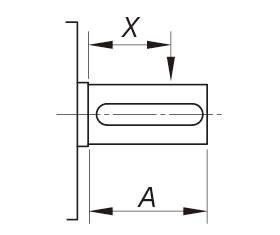
O.H.L.:Overhang load N{kgf}
f:Transmission element factor (Table 4)
Lf:Factor by load acting position (Table 5)
T:Necessary input torque N・m{kgf・m}
D:Pitch circle diameter of sprocket, gear, pulley, etc. m
Allowable O. H. L. ≧ 2×T×f×Lf D
Table 4 Transmission element factor (f)
| Chain | Gears Toothed belt | V-Belt |
|---|---|---|
| 1.0 | 1.25 | 1.5 |
Table 5 Factor by load acting position (Lf)
| X/A | 0.25 | 0.5 | 0.75 | 1.0 |
|---|---|---|---|---|
| Lf | 0.9 | 1.0 | 1.15 | 1.25 |
Table 6 Allowable overhang load
| Model | ZCA25 | ZCA35 | ZCA45 |
|---|---|---|---|
| Allowable overhang load N{kgf} | 638{65.0} | 946{96.4} | 2065{210.5} |
9.Select optional accessories
Select options that best suit your needs.
- ・Mounting Base
- ・Cap
- ・Bellows
- ・Grease plate
10.Determination of model No.
11.Calculate required input capacity (Without motor )
Required input capacity P kW = T×N/9550
Notes :
When the mean unloaded operating torque makes up 25% or more of the required input torque, the torque fluctuation caused by the chains engaging becomes larger. For smooth operation of the unit, select a model by increasing the mean unloaded operating torque (Table 3) as 1.5 times.
Be careful when selecting required input torque
When ZCA units are arranged in tandem as shown below, confirm that the required torque of the drive source is less than the allowable input shaft torque.

Two units’ worth of required input torque is being transmitted to the input shaft on ZCA (1) on the drive source side.
Confirm that the combined torque of the two units falls below the allowable input shaft torque.
Required input torque on ZCA (1) T1
Required input torque on ZCA (2) T2
Required torque at the motor TM = T1 + T2 < Allowable Torque on Input Shaft
Selection example
Machine to be used ..... Lifter using two ZCA units, indoor use (factory) (Ambient temperatures, no dust )
Required thrust ..... Light impact, 1200 N {122 kgf}/2 units, geared motor with brake installed separately and connected by couplings
Mounting style ..... Four guide poles (lifting installation )
Operating speed ..... 250mm/s((Rated speed :Acceleration/deceleration not determined )
Stroke ..... 450mm
Power Supply ..... 200V/60Hz
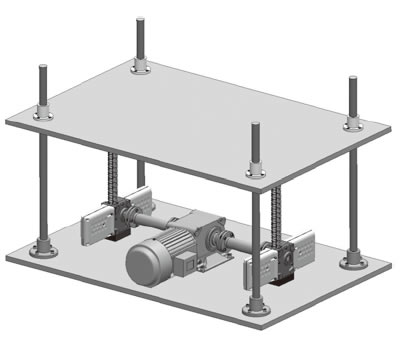
| SI Unit |
|---|
ZCA
Motor (60Hz)
Coupling
|
| {Gravity unit } |
|---|
ZCA
Motor (60Hz)
Coupling
|
When position control is needed, use a motor with an encoder or a servo motor.
(Contact a Tsubaki representative about using a motor with an encoder. )
The selection example above is just an example. Refer to the appropriate catalog when selecting the coupling, miter gear box, and motor.
Drive section
Hypoid Motor TA/TR Series

- ・Using a high-efficiency hypoid gear, TA/TR Series are a compact geared motor with minimal height.
- ・Easy to use design with Tsubaki unique grease leak prevention feature and also available with multi stop positioning control with encoder type option.
Miter Gear Box
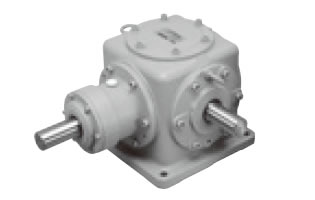
- ・The miter gear box ensures synchronized operation of multiple Zip Chain Actuators.
- ・A wide variety of options for standard models, including size, shaft arrangement, speed ratio, and material.
ECHT-FLEX Coupling
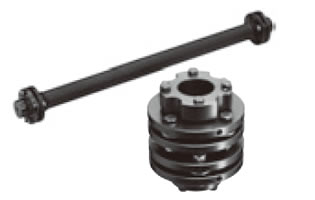
- ・Lubrication-free high-precision coupling is also available for servo motor drive options.
- ・A wide variety of shaft coupling methods—including keyways, clamps, and taper locks—and detailed shaft bore machining at 1 mm increments.

